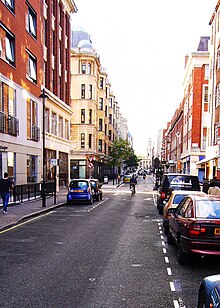Bolsover Street

Bolsover Street looking north towards Holy Trinity Church and Regent's Park
|
|
| Former name(s) | Norton Street |
|---|---|
| Length | 0.2 mi (0.3 km) |
| Postal code | W1 |
| Coordinates | 51°31′19.3″N 0°8′34.6″W / 51.522028°N 0.142944°WCoordinates: 51°31′19.3″N 0°8′34.6″W / 51.522028°N 0.142944°W |
| south end | New Cavendish Street |
| north end | Great Portland Street |
Bolsover Street is in the Parish of St Marylebone in London’s West End. In administrative terms it lies within the City of Westminster's Marylebone High Street Ward and is partly in the Harley Street Conservation Area whilst also sitting on the edges of the Regents Park and East Marylebone Conservation Areas.
The predominant land use on Bolsover Street is office business use, mixed with hotels (and YHA Hostel), medical and professional activity. Numerous communications, new media and broadcast entities are located in offices on the street. Residential presence on the street is strongest at its northern and closest end to Regent's Park and Regent's Place. The Royal National Orthopaedic Hospital has been present on the street since 1907.
Bolsover Street – part of the Portland Estate – was laid out as part of the overall development of this area in the 18th century, originally under the name of Norton Street and Upper Norton Street. Prior to this, Rocque’s map of c 1746 shows the site to be mainly open fields with Bilson's farm located to the north and further buildings to the east. Small scale hand-dug quarries (pits) for road construction and ponds were also noted to be in the area at that time.
Later, in the 1870s, it had a change of name – to Bolsover Street – reflecting its links to the Cavendish family and their estate in Derbyshire. Unlike the gradual development of Great Portland Street, this street was almost entirely built up before the end of the 18th century with fairly consistent small terraces. Also around this time, the area was described to be home to many artists' and sculptors' studios.Richard Wilson, the landscape painter, Sir David Wilkie, the Scottish painter and Sir William Chambers, the architect are said to have lived on Bolsover Street.
...
Wikipedia
